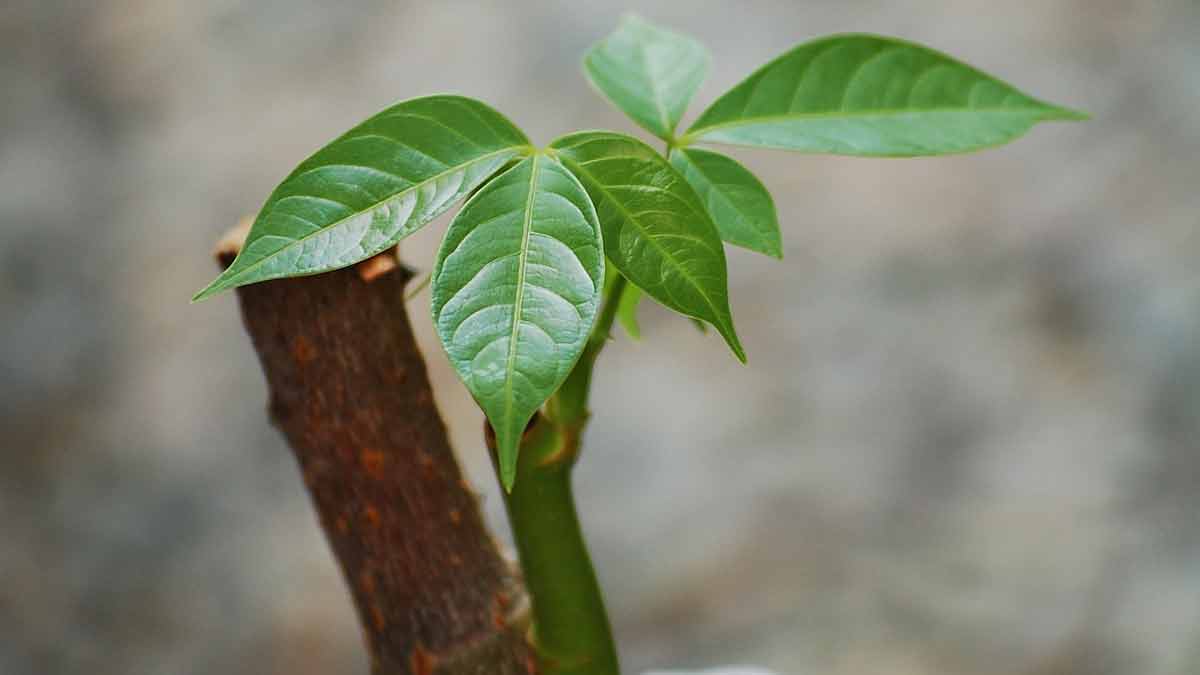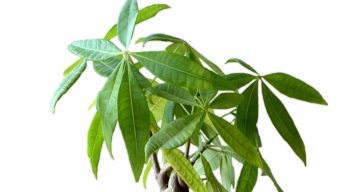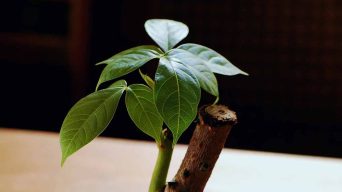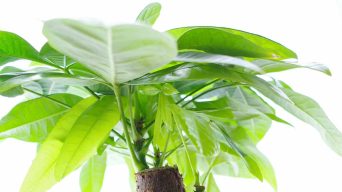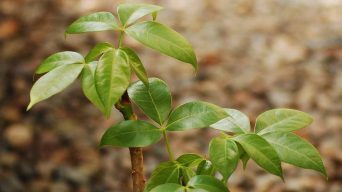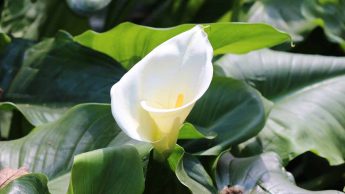Money Trees may turn brown and dry due to incorrect watering, which can cause dehydration and leaf drop. Other causes include low humidity, temperature stress, and sunburn. Overwatering can lead to root rot, making it difficult for the plant to absorb water. To fix the issue, ensure consistent watering schedules and appropriate humidity levels.
Money tree plants are known for their beautiful green leaves and braided trunks, symbolizing luck, wealth, and prosperity to those who care for them.
But what happens when your prized money tree starts experiencing browning leaves?
In this blog post, we’ll discuss the various reasons your money tree leaves may turn brown– from improper watering habits to environmental stress.
We will provide solutions and preventative measures to keep your tropical plant thriving.
Reasons Why Money Tree Leaves Turn Brown
Money trees, also known as Pachira aquatica, are popular indoor plants known for their attractive appearance and perceived ability to bring good fortune.
However, their leaves can turn brown due to various factors.
Overwatering or underwatering, insufficient light or too much direct sunlight, pests or diseases, and environmental stress can all cause the leaves to turn brown.
It is essential to understand these reasons to maintain the health and appearance of the money tree.
Overwatering Or Underwatering
One of the primary reasons your money tree leaves are turning brown is improper watering, which can mean overwatering or underwatering.
Both situations can cause stress to your plant, leading to discolored and unhealthy leaves.
Overwatering often leads to root rot, a condition that occurs when excess water prevents oxygen from reaching the roots, causing them to decay.
This directly impacts the overall health of your indoor plant since it cannot take up nutrients effectively.
Symptoms include wilting and eventually browning of the leaves as they struggle for hydration; sadly, this might look like dehydration even though you may be watering too much.
On the other hand, underwatering deprives your money tree of essential moisture.
It causes leaves to discolor at their tips and edges before ultimately turning utterly brown due to desiccation.
Lack Of Sunlight Or Direct Sunlight
A common reason for money tree leaves turning brown is an issue with their exposure to sunlight.
These plants, indigenous to South America, thrive in bright indirect light but can suffer when exposed to too little or too much sunlight.
If your money tree receives insufficient light, the leaves may lose their vibrant green color and turn dull, eventually developing brown spots and edges.
To remedy this situation and maintain a healthy money tree, place it near a window that receives ample natural light without subjecting it to strong direct sun.
You can use curtains or blinds to help filter harsh rays while allowing enough light into your home for your plant’s growth.
For instance, placing it close to a north-facing window grants access to adequate indirect sunlight that supports its well-being.
Pests Or Diseases
Pests or diseases can also be a culprit when your money tree leaves turn brown.
Spider mites, tiny arachnids resembling small spiders, love to feed on the sap of indoor plants like money trees.
They often leave behind a faint webbing and yellowing leaf surface as they suck the plant’s nutrients, eventually causing the leaves browning.
Remove any visibly affected leaves by gently pinching them off at the base of their stems to remedy a pest-infested money tree plant.
Then treat your plant with an insecticidal soap or horticultural oil spray according to the directions on the product’s label.
Be sure to address both sides of each remaining leaf for adequate control.
Over time, several applications may be spaced apart to eradicate these persistent pests.
Environmental Stress
Environmental stress is another common reason why Money Tree leaves turn brown.
Low humidity, low-quality soil, or exposure to harsh elements like hot and dry air can cause this.
A Money Tree prefers high humidity levels of around 50-60% and well-drained soil to grow correctly.
To prevent environmental stress on your Money Tree, consider investing in a good quality humidifier or placing a pebble tray filled with water near the plant.
Additionally, ensure the pot has drainage holes so that excess water doesn’t accumulate at the bottom, leading to root rot and other issues.
Using fresh soil with proper nutrients for your Money Tree will also go a long way towards preventing environmental stresses from affecting your plant’s health.
How To Fix Brown Money Tree Leaves
Revive your beloved money tree by fixing its brown leaves with simple adjustments.
Learn how to optimize watering habits, adjust light exposure, and treat pests or diseases for healthy foliage.
Discover practical techniques to bring your money tree back to life.
Adjusting Watering Habits And Frequency
One of the most common causes of brown Money Tree leaves is improper watering habits.
Overwatering or underwatering can cause stress to the plant, leading to brown spots and even root rot.
Adjust your watering frequency and habits based on the plant’s needs to fix this issue.
Regularly check the soil moisture level by inserting your finger about an inch deep into the soil.
When you water your plant, thoroughly soak it until water starts draining from the bottom of the pot.
Avoid leaving excess water in a saucer or tray underneath, as this can lead to stagnant water that can further damage roots.
Additionally, consider using well-draining soil that allows proper drainage and prevents standing water around roots.
Changing Light Exposure
Another reason your money tree leaves may turn brown is the amount of light they receive.
If your plant is in direct sunlight, it could cause the leaves to scorch and turn brown.
To fix this issue, you’ll need to adjust the placement of your money tree.
Consider moving it to a spot with bright indirect light instead of direct sun exposure.
You can also occasionally rotate your plant so that all sides receive equal light.
Remember that consistent lighting conditions are essential for healthy plant growth patterns.
Treating Pests Or Diseases
If you suspect that pests or diseases are causing the brown leaves on your money tree plant, it’s important to act quickly to prevent further damage.
The first step is to identify the type of pest or disease affecting your plant.
Common culprits include spider mites, whiteflies, and aphids.
To treat these pests, you can use an insecticidal soap or neem oil spray that targets them specifically.
Be sure to follow instructions carefully and apply as directed.
A fungicide may be necessary for fungal diseases like root rot or foliar blight.
By identifying and treating pests or diseases promptly, you can restore the health of your money tree plant before irreparable damage occurs.
Fertilizing The Soil
Fertilizing the soil is an important step in promoting healthy Money Tree leaves.
The nutrients in the soil are essential for plant growth and development.
Without them, your Money Tree may struggle to produce lush foliage.
When fertilizing your Money Tree, choosing a balanced fertilizer containing equal parts nitrogen, phosphorous, and potassium is important.
You can apply liquid or granular fertilizer once every two months during the growing season (spring through summer).
Additionally, be sure not to use too much fertilizer at one time, as it can damage the roots of your plants.
If you notice any signs of overfertilization, like leaf discoloration or browning near leaf tips or edges – scale back on using fertilizers until normalcy returns.
Preventative Measures For Healthy Money Tree Leaves
You can take several preventative measures to maintain the health of your money tree leaves.
These include using appropriate soil that drains well, consistently watering your plant, adding humidity with a humidifier or pebble tray, regularly cleaning the leaves to prevent pests, and protecting the plant from temperature stress by placing it in bright indirect sunlight.
By taking these simple steps, you can help ensure that your money tree thrives and remains healthy for years.
Using Well-Draining Soil
Using well-draining soil is crucial for healthy money tree leaves.
Money trees are susceptible to root rot, which can occur when the roots sit in soggy or waterlogged soil for too long.
Mix sand and perlite into the potting soil to ensure that your money tree has proper drainage.
You can also add a layer of rocks at the bottom of the pot to aid in drainage.
Additionally, ensure that your plant’s container has enough drainage holes to allow excess water to escape freely.
Consistent Watering Habits
Consistent watering habits are crucial for the health of your Money Tree plant.
Overwatering or underwatering are the most common causes of browning leaves.
To ensure consistent watering, it’s essential to understand how often and how much water your Money Tree needs based on its size, soil type, and environment.
To prevent overwatering, ensure your pot has proper drainage and avoid leaving standing water in saucers or trays.
On the other hand, underwatering can be just as harmful to your plant as overwatering.
A consistent watering schedule considering under and overwatering risks can help maintain healthy green foliage on your beautiful Money Tree plant!
Adding Humidity With A Humidifier Or Pebble Tray
Money tree plants are native to tropical regions and require a specific humidity level to thrive indoors.
One way to increase the moisture in the air around your money tree is by using a humidifier.
Another option is using a pebble tray, easily made at home.
Fill a shallow tray with small pebbles or stones and add water until it reaches just below the top of the rocks.
Place your money tree pot on top of the pebbles, ensuring it does not touch the water directly.
Remember that adding too much humidity can also lead to pests and diseases.
Hence, it’s important to monitor both soil moisture levels and environmental conditions regularly.
Regularly Cleaning The Leaves
Cleaning the leaves of your Money Tree is an essential aspect of maintaining its health and appearance.
Dust, grime, and other debris can accumulate on the leaves over time, affecting their ability to absorb sunlight properly.
Regularly cleaning the leaves with a damp cloth or sponge helps them stay clean and healthy.
To avoid damaging the delicate nature of your Money Tree’s leaves during cleaning, use only lukewarm water instead of cold or hot water that may shock it.
You should also avoid using chemicals or cleaners as they harm your plant’s growth.
Protecting From Environmental Stress
Maintaining consistent indoor conditions is vital to protect your Money Tree from environmental stress.
Avoid sudden temperature changes and keep the plant away from air vents or drafty areas.
Additionally, consider using a humidifier or creating a pebble tray to increase humidity around the plant.
Dirty leaves can also cause stress for the houseplant, so regularly wipe them down with a damp cloth.
By taking preventative measures such as maintaining consistent indoor conditions and regularly cleaning your Money Tree’s leaves, you can help ensure healthy and vibrant foliage.
Remember that brown leaves on your Money Tree often indicate environmental stress and should be addressed promptly to prevent further damage.
Final Thoughts
Brown leaves are a common issue for money tree plant owners, but it can be easily fixed with the proper care and attention.
Regularly checking soil moisture levels and adjusting watering habits is vital to preventing overwatering or underwatering.
Providing sufficient indirect sunlight and treating pests or diseases can also help revive your dying money tree.
By taking preventative measures such as using well-draining soil and adding humidity through a humidifier or pebble tray, you can ensure healthy growth for your money tree leaves.
Remember to regularly clean the leaves and protect them from environmental stress, such as drastic temperature changes.

